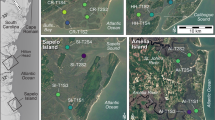Abstract
We analyzed photos of convex upward deformation in split sediment cores to obtain reasonable parameters with which to model the effect of convex upward deformation on paleolimnological data. Using a 3-dimensional raster model, we modeled the effect of this deformation on a hypothetical dataset. Model results indicated that convex upward sediment deformation integrates samples from an increasingly broader range of stratigraphic layers with an increasing degree of deformation. After applying deformation, extruded concentration profiles were nearly identical, despite varying the extrusion interval between 0.1 and 1 cm, suggesting there is a limit to the resolution that can be attained by horizontal sectioning if deformation occurred during sampling. Our data suggest that it is essential to determine the degree of sediment deformation caused by coring prior to conducting high-resolution analyses on horizontally sectioned samples.









Similar content being viewed by others
References
Acton GD, Okada M, Clement BM et al (2002) Paleomagnetic overprints in ocean sediment cores and their relationship to shear deformation caused by piston coring. J Geophys Res. doi:10.1029/2001JB000518
Aubourg C, Oufi O (1999) Coring-induced magnetic fabric in piston cores from the Western Mediterranean. Proc Ocean Drill Progr Sci Results 161:129–136
Brunschön C, Haberzettl T, Behling H (2010) High-resolution studies on vegetation succession, hydrological variations, anthropogenic impact and genesis of a subrecent lake in Southern Ecuador. Veg Hist Archaeobot 19:191–206. doi:10.1007/s00334-010-0236-4
Cocquyt C, Israël Y (2004) A microtome for sectioning lake sediment cores at a very high resolution. J Paleolimnol 32:301–304. doi:10.1023/B:JOPL.0000042995.59566.85
Dunnington DW (2015) A 500-year applied paleolimnological assessment of environmental change at Alta Lake, Whistler, British Columbia, Canada. M.Sc. Thesis, Acadia University
Glew JR (1989) A new trigger mechanism for sediment samplers. J Paleolimnol 2:241–243. doi:10.1007/BF00195474
Glew JR, Smol JP, Last WM (2001) Sediment core collection and extrusion. In: Last WM, Smol JP (eds) Tracking environmental change using lake sediments. Kluwer Academic Publishers, Dordrecht, pp 73–105
Guyard H, Chapron E, St-Onge G et al (2007) High-altitude varve records of abrupt environmental changes and mining activity over the last 4000 years in the Western French Alps (Lake Bramant, grandes rousses massif). Quat Sci Rev 26:2644–2660. doi:10.1016/j.quascirev.2007.07.007
Kegwin L, Rio D, Acton GD (1998) Intermediate depth Blake outer ridge, sites 1056, 1057, 1058, and 1059. Proc Ocean Drill Progr Initial Reports 172:77–156. doi:10.2973/odp.proc.ir.172.104.1998
Kylander ME, Ampel L, Wohlfarth B, Veres D (2011) High-resolution X-ray Fluorescence core scanning analysis of Les Echets (France) sedimentary sequence: new insights from chemical proxies. J Quat Sci 26:109–117. doi:10.1002/jqs.1438
Lane CM, Taffs KH (2002) The LOG corer—a new device for obtaining short cores in soft lacustrine sediments. J Paleolimnol 27:145–150. doi:10.1023/A:1013547028068
Martin EA, Miller RJ (1982) A simple, diver-operated coring device for collecting undisturbed shallow cores. J Sed Res 52:641
Menounos B, Clague JJ (2008) Reconstructing hydro-climatic events and glacier fluctuations over the past millennium from annually laminated sediments of Cheakamus Lake, Southern Coast Mountains, British Columbia, Canada. Quat Sci Rev 27:701–713. doi:10.1016/j.quascirev.2008.01.007
R Core Team (2013) R: a language and environment for statistical computing. R Foundation for Statistical Computing, Vienna
Reasoner MA (1993) Equipment and procedure improvements for a lightweight, inexpensive, percussion core sampling system. J Paleolimnol 8:273–281. doi:10.1007/BF00177859
Rosenbaum JG, Skipp G, Honke J, Chapman C (2010) A composite depth scale for sediments from Crevice Lake, Montana. United States Geological Survey Open File Report 2009-1277, Reston, Virginia
Spooner IS, Hills LV, Osborn GD (1997) Reconstruction of holocene changes in alpine vegetation and climate, Susie Lake, British Columbia, Canada. Arct Alp Res 29:156–163. doi:10.2307/1552042
White HE (2012) Paleolimnological records of post-glacial lake and wetland evolution from the Isthmus of Chignecto region, eastern Canada. M.Sc. Thesis, Acadia University
Wickham H, Francois R (2016) Dplyr: a grammar of data manipulation. R Package version 0.4.3
Wickham H, Chang W, RStudio (2016) Ggplot2: an implementation of the grammar of graphics. R Package version 2.1.0
Wright HE (1993) Core compression. Limnol Oceanogr 38:699–701. doi:10.4319/lo.1993.38.3.0699
Acknowledgements
We acknowledge funding from the Natural Sciences and Engineering Research Council (NSERC) of Canada, the insightful comments on this manuscript from both anonymous reviewers, and Mark Brenner for editorial handling.
Author information
Authors and Affiliations
Corresponding author
Rights and permissions
About this article
Cite this article
Dunnington, D.W., Spooner, I.S. Modeling the effect of convex upward sediment deformation and horizontal core sectioning on paleolimnological data. J Paleolimnol 57, 361–368 (2017). https://doi.org/10.1007/s10933-017-9947-1
Received:
Accepted:
Published:
Issue Date:
DOI: https://doi.org/10.1007/s10933-017-9947-1




